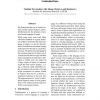Free Online Productivity Tools
i2Speak
i2Symbol
i2OCR
iTex2Img
iWeb2Print
iWeb2Shot
i2Type
iPdf2Split
iPdf2Merge
i2Bopomofo
i2Arabic
i2Style
i2Image
i2PDF
iLatex2Rtf
Sci2ools
100
click to vote
COLING
2010
2010
Improving Name Origin Recognition with Context Features and Unlabelled Data
We demonstrate the use of context features, namely, names of places, and unlabelled data for the detection of personal name language of origin. While some early work used either rule-based methods or n-gram statistical models to determine the name language of origin, we use the discriminative classification maximum entropy model and view the task as a classification task. We perform bootstrapping of the learning using list of names out of context but with known origin and then using expectation-maximisation algorithm to further train the model on a large corpus of names of unknown origin but with context features. Using a relatively small unlabelled corpus we improve the accuracy of name origin recognition for names written in Chinese from 82.7% to 85.8%, a significant reduction in the error rate. The improvement in F-score for infrequent Japanese names is even greater: from 77.4% without context features to 82.8% with context features.
COLING 2010 | Computational Linguistics | Context Features | Discriminative Classification Maximum | Infrequent Japanese Names |
Related Content
| Added | 13 May 2011 |
| Updated | 13 May 2011 |
| Type | Journal |
| Year | 2010 |
| Where | COLING |
| Authors | Vladimir Pervouchine, Min Zhang, Ming Liu, Haizhou Li |
Comments (0)

